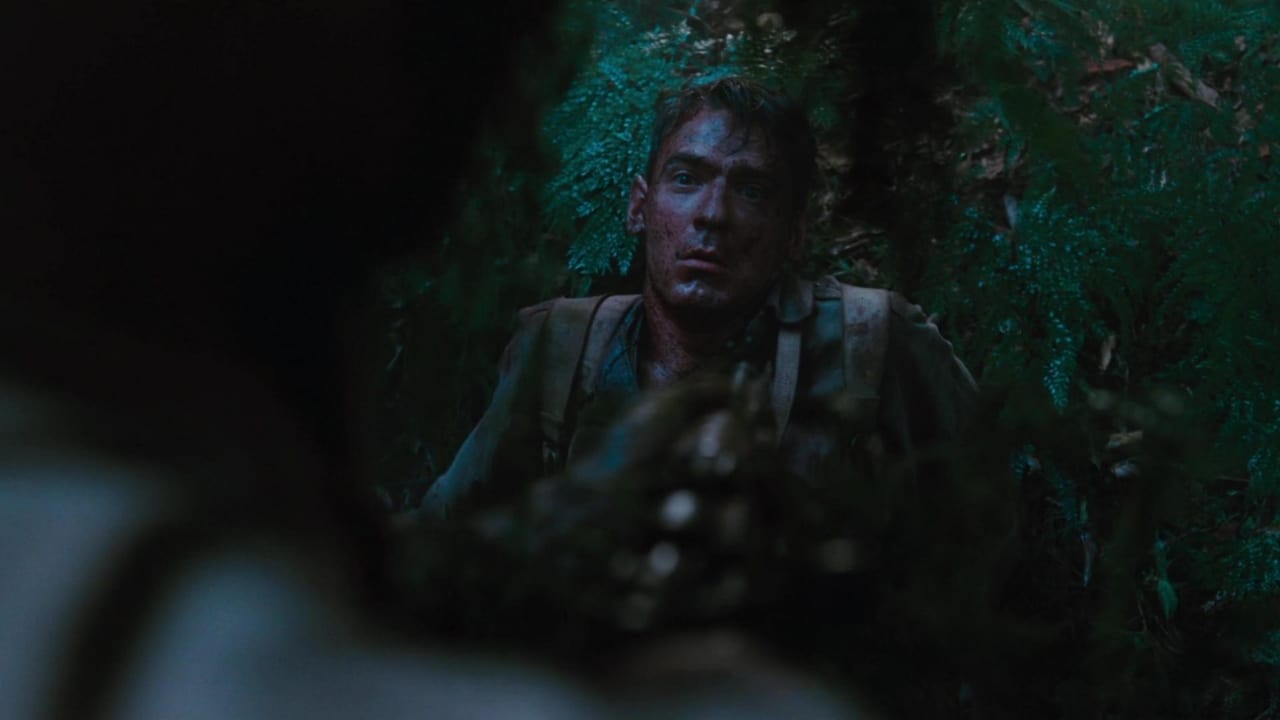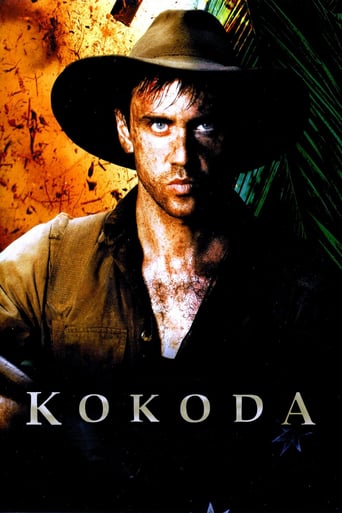



Good concept, poorly executed.
Although it has its amusing moments, in eneral the plot does not convince.
View MoreIf you're interested in the topic at hand, you should just watch it and judge yourself because the reviews have gone very biased by people that didn't even watch it and just hate (or love) the creator. I liked it, it was well written, narrated, and directed and it was about a topic that interests me.
View MoreMostly, the movie is committed to the value of a good time.
View MoreKOKODA 2006 This Australian war film is about a small group of Australian soldiers during the Kokoda Track campaign of 1942. The men, part of the Australian 39th Battalion are sent deep into the mountains of New Guinea to try and stop the Japanese from reaching Port Moresby. The Japanese had landed a large force on the far side of the island, and are crossing over the Owen Stanley Range to take Port Moresby. Most of the Australian Army was fighting in North Africa, or had been lost in the fight for Singapore and the Dutch East Indies. The 39th was one of the few units available. It consisted mostly of untrained militia and soldiers considered unfit for combat. The film starts with a section of men assigned to a forward post on the Kokoda Track. Their job is to warn the main body of the troops if the Japanese show. The Japanese do show, and quickly flank the group. The survivors hot foot it into the jungle to escape. The half dozen men left now need to attempt to reach their own lines.The men quickly run out of food and fresh water. Most have malaria and are suffering from dysentery. They move on the best they can trying to avoid Japanese patrols. One by one the group is reduced from clashes with the opposing forces. One man is wounded and wanders off into the jungle to die. Another is shot up and left in an old native hut.Several days later, two of the men, starving and exhausted, manage to hook up with some Regular Australian Army units. The Regulars have just reached the area, and are having their own problems with the Japanese. Fighting in the open North African desert, is not the same as the dense humid jungle. The militiamen soon find themselves back in the fight as the Japanese launch a big attack. The attack fails, but the undermanned Aussies still need to fall back. Another of the men is killed, but the man left at the native hut has been brought in by several natives. The slow retreat continues almost to Port Moresby. The Japanese though have shot their bolt. They are now at the long end of a supply line. They are recalled back to the other side of the mountains. The long battle now continues back over the mountains in pursuit of the Japanese. The 39th though, what is left of them, are withdrawn. The cast is made up of, Ben Barrack, Simon Stone, Ewen Leslie, Christopher Baker, Travis McMahon, and Jack Finsterer, Luke Ford and Steve Le Marquand.First time feature film director, Alister Grierson, deserves full marks here. This is one nasty, brutal, war film. The cinematography by Jules O'Loughlin is simply fantastic, showing the viewer just how claustrophobic jungle warfare was. The Japanese are seldom shown except as shadows through the dense undergrowth. Most of the time they are right on top of the Aussies before they are seen. O'Loughlin was nominated for best cinematography by various Australian cinema award venues. All in all, this is a very good war film.
View MoreI honestly cannot believe some of the reviews I have read here about this movie and most of them are by Australians! When it comes to downplaying our history and not giving thanks to the men and women whose sacrifices actually have allowed us the benefit of being able to give an opinion without being dragged from our beds and executed, I honestly used to think Canada held the distinction for being number one, but you guys take the cake.People wanting this to be more like "Saving Private Ryan" or calling it a Propagandist movie? REALLY? The person who said that we should not be bringing up some of the war atrocities by the Japanese really needs to buy a reality check. World War II was not pleasant, it was not what Hollywood made it out to be in the 50's and 60's and the most brutal examples of inhumanity happened in the Pacific Theater, including brutality to the Winnipeg Rifles (Canadians captured while defending Hong Kong) I knew nothing about this engagement before seeing this movie and all I can say is if something like this had happened between U.S. troops and the Japanese there would be hundreds of books and movies regaling us all with the magnificent heroics of the men involved.My hat is off to the first-time director who managed to pull this together and tell a story that REALLY needs to be told. Watching a movie like this or reading a book about it is in a way, an opportunity for the viewer or reader to say THANK YOU to the men that served.To those of you, especially those of you from Australia, who had your sensibilities hurt by it and gave it a low rating, SHAME on you! The movie is worthy of watching if for no other reason than learning about some of the history of World War II.
View MoreI had this misfortune to watch the film Kokoda last night. When I say misfortune I mean the display of mans inhumanity to man. It depicted the joy the Japanese had in mutilated our diggers. One slowly bayoneted through the eye, another tied up and repeated bayoneted, another throat cut.Do we need the graphic evidence on the screen in our living room. I don't think so. We all have to live together in this world and we don't to revive the hate for other races. We see enough of this on the news. As far the making of the movie I believe it was world class and the graphics were a bit too graphic.To those that loved the movie and would see it again I would consider this. What you lived through in the horror you witnessed on the screen is only part of the terror. Add to this the constant heat ad humidity. The bugs, the snakes the stink of human excrement and rotting bodies and of course the rain. Then is this isn't enough try the bugs that clime up your ass when you cross the rivers.Not to mention the other vermin in the water and on the land. Then add the enemy could and possibly was within arms reach waiting to catch you off guard. How would have handled this. How would you have survived and the guys that returned to there family's were total strangers. Most of them unable to love or show affection. There is another side to war the government don't want to show us.During my days in the Military Police (Provo Corp) in Australia during the Vietnam war I met a medic that talked about return guys that were only part of a man. Half a face, legs and arms missing. Audie Murphy, the highest decorated soldier in the American Forces during the Second World War said when asked, how does anybody survive a war, he answered "nobody ever does". He slept with a loaded 45 pistol under his pillow and blew the light switch of the wall one night.Sure, see the movie if you must. But then forget it if you can. Yes, if you can for what you see on the screen while you eat your popcorn and drink you soda drink is only 10% of the terror. One more thing I may add, lets not forget the magnificent job the U.S. Forces did in the Coral Sea and he Philippines.Thousand of Americans gave their lives making the difference and helping to keep us safe. This during a time when Briton turned its back on us. For with out the Americans sacrifice New Guinea wouldn't have mattered. I am not selling the Australian diggers short.They did a great job given the out of date weapons and equipment they had. The natives also played a very big part in the campaign as well for without them we would have lost the battle. They would send radio messages in local dialect totally confusing the Japs. They also looked after our wounded and carried them many miles were just some of the help they gave us. I believe they were never given enough credit for the contribution.By the way on the technical side of the motion picture. Where were the Owen Sub machine guns that were used in New Guinea. All I saw were the First World War out dated lee-Enfield 303,s and a Thompson America sub machine gun. I don't think the Thompson were used that area. Surely they could have found one Owen. Enough of war movies.We all need to learn to live together and we all need to be happy. The sacrifices made by thousands of our diggers and our allies were all caused by a few greedy and power seeking men with giant egos. Mans inhumanity to man. War instigated by a few, paid for by millions of lives. I won't be watching the movie Kokoda again.
View MoreIt's funny that the ending of this film has been criticised here as unrealistic and melodramatic. One commenter even said it was of "Neighbours" (soap opera) quality.In fact the final scene is an exact reconstruction of a parade of members of the 39th battalion before their commander, Lieutenant Colonel Ralph Honner at the village of Menari. Every word spoken by William McInnes (playing Honner) in this scene is taken from the official record of the proceedings on that day.So much for "Neighbours".The film is good without being great. The budget supplies the reason. What it does convey is the hostile terrain over which the Australian soldiers had to lug all their supplies, including heavy artillery pieces... and then they had to fight the Japanese, who heavily outnumbered them, when they reached the top of the ranges.These were part-time soldiers, reservists with inferior training and green troops for the most part. Their job was to hold the line until the professional veterans (back from North Africa) arrived to take over. It was a war fought in platoon and section strength, with few pitched battles. Ever since the survivors of the two reserve battalions have been called "The Ragged Bloody Heroes", and deservedly so.Recently these has been some revisionism among politically biased historians, claiming that Kokoda was a waste of time and effort; that the Japanese had no intention of invading Australia. While they may not have been as serious about Kokoda as they were regarding the developing disaster at Gualalcanal, one thing is certain: if the Japanese had not been held back on the Kokoda Track, taking Port Moresby would have been a prize too easily won to refuse. Taking Moresby, and perhaps then Australia could have changed not only the war in the South West Pacific area, but perhaps the whole course of WW2.The men of the 39th battalion had no opportunity to speculate from afar, and safety, on the political potential of Kokoda as relevant to 2006 politics. They had to fight and die where they stood. That is why their story is worth telling, a story of small groups of men fighting shadows in a jungle nightmare scenario, without the option of surrender.
View More